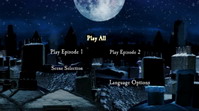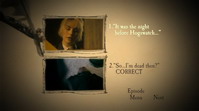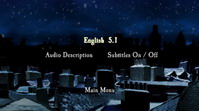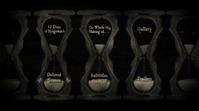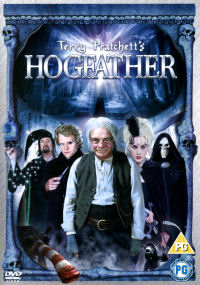
23.12.2007 #430
English Version 20.05.2013
by Guido Bibra
• Gallery
• Exclusive Deleted Scenes
• The Making of Hogfather
![]() The Series
The Series
It's Hogswatch on the Discworld. Susan, who by complicated family relations is Death's granddaughter, just wants to live a normal life as a governess to two children of a rich family in Ankh-Morpork and have a quiet evening before the holiday. To her surprise, Death and his servant Albert slide through the chimney instead of the Hogfather, whose job they have taken over. But her grandfather does not want to tell her what happened to the real Hogfather and so she uses her inherited skills to go on a search to find the bearded man in the red mantle...
The more brilliant Terry Pratchett's fantasy satires are, the more unfilmable they get. The scenery of the Discworld, a flat world resting on the backs of four elephants standing on a giant turtle, is much too unconventional for mainstream cinema especially in the USA, which has thwarted many efforts to adapt his novels for cinema or television. However, in the late 1990s, two brilliant animated adaptions were made for Channel 4 in England by the renowned studio Cosgrove Hall, even with the cooperation and blessing of the author himself. But these remained a big exception for a long time.
After a big-budget Hollywood-adaption in the style of Lord of the Rings had never materialized because of the very special British humour of the Discworld universe, around 2005 the UK television entertainment industry began to get interested in Terry Pratchett's ideas. In February 2006, a surprising announcement was made that the British pay-tv channel SkyOne together with the American RHI Entertainment were going to produce Pratchett's Discworld novel Hogfather for television. It was to be the very first live-action version of a Discworld story - it was an endeavour which the author had not entrusted to just anybody, but a team of brilliant filmmakers and producers.
SkyOne as the British branch of Rupert Murdoch's media empire is not really known for high-quality original productions, but proved to be ideal - and very necessary - as a financial backer and platform for an elaborate adaptation. The American partner was RHI Entertainment, the company of Robert Halmi Junior and Senior, who had been producing excellent television series and movies for over thirty years. But the actual production was put into the capable hands of a group of British filmmakers called The Mob, whose co-founder, author and director Vadim Jean had already made himself known with little comedies like Leon the Pig Farmer and The Real Howard Spitz.
For the first Discworld live-action adaptation, the choice was not one of Terry Pratchett's early novels, but something more appropriate for the Christmas programming: Hogfather, the 20th Discworld novel, had been published in 1996 and was the fourth in a series about Death and his extended adopted family - in this novel his now grown-up granddaughter Susan. It may not be the ideal starting point into the Discworld universe, but with the scenery of Ankh-Morpork, the appearance of the wizards of the Unseen University and many other elements from earlier books, Hogfather is actually a great mix of the best components of all Discworld stories and even enjoyable without any previous knowledge.
Responsible for the script writing was director Vadim Jean, while Terry Pratchett himself was listed as "mucked about by" in the credits. Whether this only served as a reassurance for the fans or Terry Pratchett had really worked on the script was never explained, but the author later said that he always leaves the scriptwriting in the hands of the filmmakers, only giving advice when it is really needed. Considering the very true to the original adaptation of Hogfather, it must have been a very friendly and productive cooperation. Vadim Jean had really managed to reproduce the unique style of the author in his script, although some inevitable abridgments were of course necessary. But the trimming was so careful that the script leaves the impression of being based on a new treatment written by Terry Pratchett himself.
Thanks to a generous running time of three hours split into two 90-minute episodes, the streamlining of the book was not as bad as it could have been and was basically limited to the removal of a couple of secondary characters and some less important subplots. Otherwise the story itself had not been modified much and while the dialogue was also tightened, most of it had been taken straight from the book with only minor rewriting and no major additions were made. Even compared to the original novel the cuts are not really noticeable, because they were made sensibly - something many other film adaptations never managed to do.
Even more difficult than the transformation from book to script proved to be the casting, because most of the characters had not been newly created for this story, but were old-established friends from many previous book, which had been brought to life in illustrations before. The casting had to be done very carefully, but the filmmakers demonstrated a remarkable accuracy, which surely also had to do with Terry Pratchett's own involvement in the preproduction, because nobody knows the characters of a book better than its own author.
The main character of Hogfather is a young woman called Susan with a very unique past, which Terry Pratchett has chronicled in the two earlier Discworld books Mort and Soul Music: she is Death's adopted granddaughter and mainly human, but she becomes involved in the "family business" when her Grandfather is indisposed. For this unusual character the filmmakers made a brilliant choice by finding the almost unknown theatrical actress Michelle Dockery, who manages to bring her character so wonderfully to life that it is hard to imagine anyone else in this role. With exactly the right cold, but resolute and sympathetic way Michelle Dockery plays her character very natural and relaxed, making Susan the real hero of the story like in Terry Pratchett's story.
On the Discworld, Death is not primarily a state or an event, but a two-meter skeleton with cloak, scythe, horse... and a huge personality. He is a complex, multi-layered character, who appears in every Discworld story - but not as an antagonist, but actually as a very likeable fellow who has a job to do and even some problems himself. Instead of making Death a completely computer-generated character, the filmmakers made the wise decision and relied on a large actor with a mask and long-fingered hand prostheses, which were designed so well that they don't leave a cheap impression at all. Behind the mask was the dutch actor, dancer and acrobat Marnix van den Broeke, who had the difficult task to move to the pre-recorded dialogue - which, in spite of the immobile mask, was surprisingly successfull, but would not have been possible without a fitting voice.
Death's voice had been provided by Christopher Lee in the animated adaptions, but for Hogfather the filmmakers had found an equally brilliant actor in Ian Richardson who had become famous in british television and theatre by playing everything from Sherlock Holmes to Shakespeare and even political thrillers like Tinker Tailor Soldier Spy and House of Cards. While not as deep and sonorous as Christopher Lee, his very distinct vioce nevertheless was perfect for the character, who was described by the author as sounding like slamming coffin lids. No special audio engineering was needed, the actor is heard with his natural voice and was able to literally bring Death to life with his wonderful performance. Unfortunately it was one of Ian Richardson's last appearances - the actor had passed away unexpectedly in February 2007.
Death's servant Albert actually has only a relatively small role in Hogfather, which was not particularly extended for the television adaptation, but on obvious pressure from the financiers had been cast with a british star. David Jason was and is one of the most beloved british television actors, who had first become famous as a comedian in the BBC sitcom Only Fools and Horses in the 1980s, but was also successful in more serious roles like in the crime series A Touch of Frost. He was a perfect and logical choice for Death's cynical, but good-natured sidekick Albert, bringing exactly the right grumpyness and crusty comedy to the character. David Jason had visible fun with his role, it seems he was really delighted in being able to play a humorous character again after a long time. Surprisingly, David Jason had been singled out as the lead actor of the film - something which especially fans were really anxious about before the first premiere. But in spite of the marketing campaign, the character was very close to the novel and had neither been thrust in to the foreground nor exessively rewritten.
Nearly every Discworld story has its own special antagonist, with whom Terry Pratchett parodies classic bad guys - in Hogfather it is Mr. Teatime, a psychopatic killer who is even unnerving to the Guild of Assassins. This not altogether easy role was filled by Marc Warren, a very busy british television actor, who had taken Johnny Depps apperance in Charlie and the Chocolate Factory as one of his models and so leaves the brilliant impression of being a murderous Willy Wonka. While the childlike voice, which was never mentioned in the book, needs a little getting used to, it actually fits Mr. Teatime very well and allows Marc Warren to make much more out of his character than any old villain. With his emphatic and haunting appearance, the actor would not even have needed the spooky contact lenses, but without them, Mr. Teatime would not have been entirely complete.
The crooks hired by Mr. Teatime have been reduced by two in the film version, but Peter Guiness as Medium Dave, Stephen Marcus as Banjo and Craig Conway as Chickenwire are nevertheless a great representation of the lovable band of scoundrels, whose little nuances and idiosynchracies have not been lost. For the role of the nervous wannabe wizard Mr. Sideney the filmmakers were able to cast a Discworld veteran: Nigel Planer is not only a very busy British actor, writer and musician, but he has also read many of the unabridged audiobook versions of Terry Pratchett's novels. He played his character somewhere between simple stupidness and clever incompetence and was able to make much more out of Mr. Sideney than just a tragic and funny secondary figure.
The faculty of the Unseen University plays a large role in Hogfather, making the casting of the wizards, which had been a fixture in the Discworld stories for a long time, especially difficult. The filmmakers were aware of the fans' anticipation, but they did not disappoint at all and managed to find exactly the right actors. Brian Blessed had been one of the candidates for Archchancellor Ridcully, but Joss Ackland was an even better choice. The British actor with a career reaching back over fifty years seems to have informed himself extensively about the background of his adventurous, no-nonsense head wizard and embodies Mustrum Ridcully exactly like Terry Pratchett has imagined him in many of his books.
Ridcully's colleagues had also been cast very appropriately: John Franklyn-Robbins as the Dean, Timothy Batheson as the Lecturer in Recent Runes, John Boswall as the Chair of Indefinite Studies and Roger Frost as the Bursar are a magnificent representation of the book's characters. In contrast to their almost modern archchancellor, they leave the wonderful impression of being lazy academics who love big dinners, long naps and no disturbances from unruly students. The latter are represented only by Ed Coleman as Ponder Stibbons, the most prominent of the next-generation-wizards, showing that there are also students and even geeks and nerds in the magical college. Unfortunately Stibbons' colleagues are only seen in the background, while they have somewhat larger roles in the book.
Even all the smaller characters had been remarkably cast - Nicholas Tennant and Richard Katz as Corporal Nobbs and Visit from the City Watch bring the two well known figures wonderfully to life and Tony Robinson, who is one of the three main Discworld audiobook readers, makes a brilliant last-minute surprise appearance as shopkeeper Mr. Crumley. Rhodri Meilir plays the unfortunately somewhat trimmed role of the Oh God of Hangovers with a wonderful british accent and Sinead Matthews as the bubbly Tooth Fairy had also been perfectly chosen. David Warner has a quick cameo as the head of the assassin's guild at the beginning of the first episode, but the icing of the cake was the very brief, but wonderful appearance of Terry Pratchett himself as a toymaker, a little treat the author had really deserved.
For a long time, the Discworld has not only existed in form of words, but has always been illustrated on book covers, artwork portfolios and other material. Not only the characters, but the scenery has been extensively visualized. In 1993 a detailed map of Ankh-Morporh had been released, followed in 1995 by a map of the whole Discworld. There were enough visual guides, and they were used to their full extend - some of the storyboards for Hogfather were illustrated by Stephen Briggs, who worked on the maps together with Terry Pratchett and even Bernard Pearson, who became famous in the Discworld fan scene with his elaborate sculptures and models of the Discworld, was involved in the production design of the movie.
Although the budget of six million pounds for a three-hour-production was very generous, really elaborate sceneries were not really possible. But Vadim Jean and his team had found a good compromise to ensure an atmospheric, true to the original adaptation - the production was made in a somewhat small and humble format. The pseudo-victorian Ankh-Morpork had been brilliantly designed and while outside locations have been only used sparingly, the wonderfully designed studio were so detailed that it doesn actually matter where the plot happens. Even Unseen University does not look as large as many fans might have imagined, but the atmosphere is spot-on and many small details in the environment, including the wonderfully designed Discworld computer Hex, can be instantly recognized.
One of the reasons there had not been a real-life adaption of a Discworld novel yet were the missing possibilities in the field of special and visual effects. Terry Pratchett imaginative sceneries are not a problem when they are written on a page and even possible in animation, but only in the last ten years a really adequate realization of Pratchett's ideas had become possible and affordable. Although Hogfather was actually one of the more down-to-earth Discworld stories, a lot of scenes were only possible with the help of computer-generated sceneries.
These effects were produced by the London Moving Picture Company, one of the leading british studios in this field. In spite of the limited budget and tight deadlines they made a huge effort, integrating the effects seamlessly into the real footage shot with digital cameras - only some of the greenscreen footage combined with CGI sometimes looks a little artificial. The title sequence is, howevery, truly remarkable - a tour around the whole Discworld in space, which had been produced with early CGI for the animated series before, but now looks even more impressive.
While the two animated adaptations from Cosgrove Hall had a folk music orientated soundtrack to offer, a classic orchestral film score was the only viable alternative for Hogfather. For this, director Vadim Jean had called up David A. Hughes, an old friend with whom he had already worked together on two of his previous movies. Hughes, an extremely busy film and television composer with an experience of more than fifteen years, was very well suited for a project like Hogfather. His huge challenge was to set a scenery with a long backstory to music and to satisfy the huge expectations of the viewers and fans.
The result was a fully-grown film score, which was surprisingly elaborate and complex for a television production. Of course no pop music was used, which would have been completely wrong for the story, but the musical theme of Christmas, or more correctly, Hogswatch, was needed nevertheless. There is no extensive carol singing, but overall David A. Huges had taken the somewhat sinister and moody style of Danny Elfman's Nightmare before Christmas to heart and composed many wonderful melodies and themes, which are an invaluable contribution to the festive, but also spooky atmosphere of the story.
It had taken a long time, but it was worth the wait: the Discworld finally had made the jump from literature to live-action film. In spite of many concerns and worries about wrong interpretations of the book and miscastings, Hogfather can only be called a full success. This was only possible because Terry Pratchett had finally found a great collaborator in Vadim Jean and The Mob, who were able to bring the vision of his imaginative stories properly to life. A careful adapted script, brilliant actors, an impressive scenery and strong direction made Hogfather a wonderful adaptation of the twentieth Discworld story. It was an amazing christmas present for fans of Terry Pratchett's Discworld universe and even for casual viewers, although without any previous knowledge some parts of the story may be a bit hard to follow.
Hogfather was premiered on December 17th and 18th 2006 on SkyOne in England and became a huge success, partly thanks to a well-orchestrated marketing campaign. Even long before the television broadcast SkyOne had resolved most of the doubts by a series of well-produced web videos about the making of the film and after the premiere both fans and critics both fans and critics agreed that the first Discworld live-action adaptation was a success on the very first try - and even Terry Pratchett was very happy with the result.
Hogfather also had opened the door for more live-action adaptations and only a short time after the premiere the next project was announced by Sky One: The Colour of Magic and The Light Fantastic had been chosen for the next three-hour, two part film to be made by the same team as Hogfather. The third collaboration between The Mob Film and Terry Pratchett, Going Postal, was made in 2010 - and it won't be the last.
![]() The DVD
The DVD
When Hogfather premiered in December 2006 on SkyOne, a DVD for Spring 2007 had already been announced and the two-parter was finally released in April of that year by 20th Century Fox in England. There were two different versions at the beginning: a limited edition in a digipack signed by Terry Pratchett and a less expensive release in a keepcase with a cardboard slipcase - although both contained exactly the same 2-disc-set with identical extras. Later in November 2007 a single-disc-version without extras had also been released in England, but the lack of the interesting bonus materials makes this version not very interesting. Although the film was shot and broadcast in high-definition, a Blu-Ray has not been released in the UK.
The DVD reviewed in this article is the non-limited British 2-disc-set, which is absolutely excellent in both technical quality and content. In December 2007 Hogfather was also released in Germany by Eurovideo, but while this edition contained all important extras of the UK disc, the original soundtrack was only provided in 2.0 and not 5.1. Eurovideo had also released a Blu-Ray in late 2010, which offers the only high-definiton version of Hogfather available and also has extras, but it also lacks an english 5.1 soundtrack which is only available in 2.0 like on the German DVD.
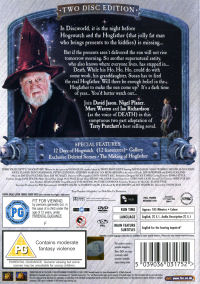
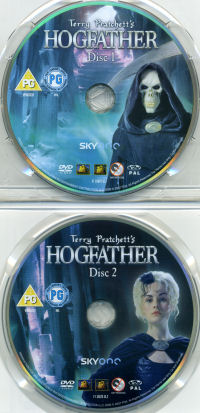
![]() Image
Image
Back in 2006, Hogfather had been one of the first british television productions shot completely with digital high-definition film cameras. The camera used was Arriflex' then-new D20, which had an image sensor the size of a Super35 frame, allowing for the same operation as a common 35mm camera. As a result, the image on this DVD does not leave the impression of a clinically sterile digital production, but looks more like a clean, modern transfer of an analogue film source.
The conversion of the digital high definition master is an excellent example how good a DVD in standard PAL resolution can look. Especially impressive is the very detailed image, which did not need any additional help to provide a sharp and almost three-dimensional image. At first glance, the image may look a little soft because no additional sharpening has been applied, but altogether this DVD looks very natural and above all completely unfiltered. The image is almost perfect and even in the many of dark scenes there is no hint of noise or other video artifacts. The colour timing has been heavily digitally manipulated and is very subdued, contrast and brighness are also very murky - but very deliberately. There are only few really strong colours on this DVD, but in return the colour palette is very atmospheric, exactly like the filmmakers have intended.
The excellent video master is only slightly tarnished by the authoring, which does not work quite so well with over three hours of material on only one disc. While heavier compression artifacts are not visible despite a bitrate hovering only about 5 mbit/s, some of the unfocused backgrounds exhibit slight blocking and during fast camera movements the image seems to get very fuzzy for a moment.
![]() Sound
Sound
As a new and modern production, Hogfather also had an appropriate soundtrack to offer and in view of the digital television broadcast and the DVD release was mixed directly in 5.1. The UK DVD of course offers only the original English soundtrack, but also comes with a second track with an audio description.
The 5.1 track is very convincing with a very solid sound, but cannot really compete with a complex blockbuster soundtrack. Nevertheless the mix is very detailed and has a distinct surround sound, which is mainly provided by the very widely spread music, which sounds very transparent and airy without using artificial reverb or echo. Sound effects are also very distinctive and fill the frontal soundstage, while making only sparingly use of the surround channels. The dialogue mix is surprisingly playful and is not limited to the center channel, but also swerves to the far corners sometimes.
The second soundtrack is only in 2.0 surround and basically a downmix of the 5.1-track, but offers an audio description for visually impaired viewers, which was apparently made for the British television broadcast and sounds quite good. Subtitles are available in English, but they are not very accurate.
![]() Bonus Material
Bonus Material
For a television production, the bonus materials of this DVD can really hold their own, even if an audio commentary would have been a good addition to the documentaries on the second disc. Even so, extras with a runtime of more than 100 minutes are offered, which are more quality than quantity. The menu design also successfully and captures the atmosphere of the movie very well.
Twelve Days of Hogswatch (53:16) is a collection of twelve featurettes, which had been released on the website of SkyOne before the television premiere and have the subtitle Death's Guide to the Discworld. And that is exactly what the short four- to five-minute pieces are: Death, again with the voice of Ian Richardson and in the shape of Marnix van den Broeke, introduces one aspect of the Discworld in every episode and speaks to Terry Pratchett and many other people not only involved with the production itself, but also in the Discworld universe. While these mini-featurettes were primarily made for promotional purposes and contain a few film clips, they are nevertheless very well made, thoroughly entertaining and also provide a lot of background information about the scenery and the characters.
The Whole Hog - Making Terry Pratchett's Hogfather (46:47) is the actual documentary on this DVD, which takes an extensive look at the production of Hogfather. Besides providing many views behind the scenes, there are a lot of interviews with author Terry Pratchett, director and screenwriter Vadim Jean, the actors Ian Richardson, David Jason, Marc Warren, Michelle Dockery, Nigel Planer and Tony Robinson and also visual effects producer Oliver Money, who all have to say many interesting things about the making of Hogfather and do not limit themselves only to simple praise.
The Gallery has been split into the areas Behind the Scenes (10 images), Characters (12 images), Scenes (12 images) and Sketches (30 images) which are all very numerously equipped with photos and drawings, but are displayed much to small in an unnecessarily huge frame.
The Deleted Scenes My Name is Bilious. I'm the Oh God of Hangovers (2:39), Death and Albert get a surprise (0:49) and Life to the unconquered sun (0:42) are presented in good anamorphic quality, but partly with only half-finished special-effects. The scenes fill in some small gaps in the narrative, but are not really necessary for the plot.
Trailers unfortunately contains none of Hogfather, only for the Fox DVDs A Night at the Museum, Eragon, The Simpsons Movie and Rise of the Silver Surfer.
